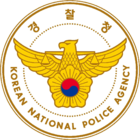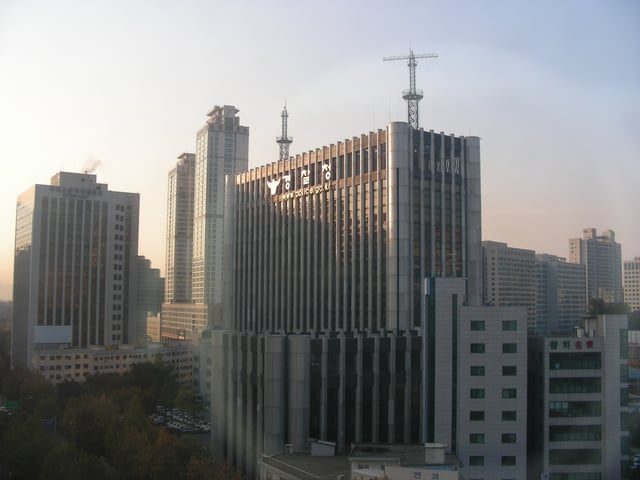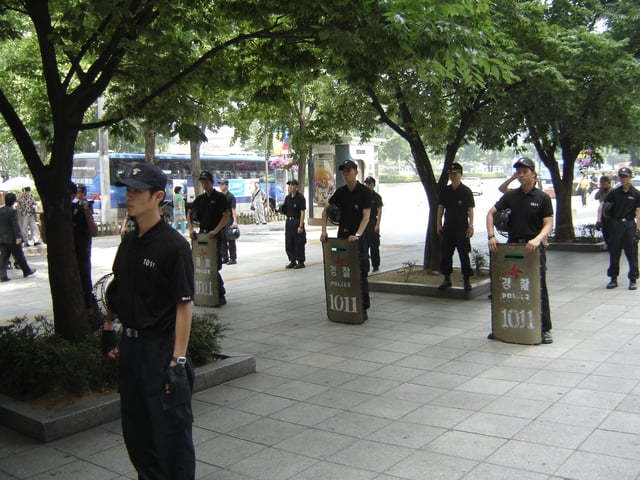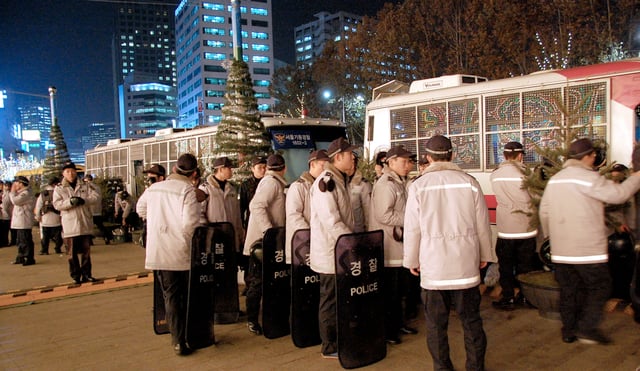National Police Agency (South Korea)
-pUfYrTAitqJ8SFCi3QnaA5dO78hLZN)
National Police Agency (South Korea)
-pUfYrTAitqJ8SFCi3QnaA5dO78hLZN)
| Korean National Police Agency | |
|---|---|
| Korean name | |
| Hangul | 경찰청 |
| Hanja | 警察廳 |
| Revised Romanization | Gyeongchalcheong |
| McCune–Reischauer | Kyŏngch'alch'ŏng |
 | |
 Badge of a South Korean police officer | |
| Common name | Korean National Police |
| Abbreviation | KNPA |
| Jurisdictional structure | |
| National agency | South Korea |
| Operations jurisdiction | South Korea |
| General nature |
|
| Headquarters | Migeun-dong, Seodaemun, Seoul |
| Police officers | 101,108 (2010)[1] |
| Minister responsible |
|
| Agency executive |
|
| Local police agencys | 17
|
| Website | |
| Official website [15] | |
The Korean National Police Agency (KNPA), also known as the Korean National Police (KNP), is one of a few police organizations in South Korea and is run under the Ministry of the Interior and Safety.[2] As a national police force it provides all policing services throughout the country.[2] The Korea Forest Service also have their own police organizations, as does the Ministry of Land, Infrastructure and Transportation to police the railroad system.
| Korean National Police Agency | |
|---|---|
| Korean name | |
| Hangul | 경찰청 |
| Hanja | 警察廳 |
| Revised Romanization | Gyeongchalcheong |
| McCune–Reischauer | Kyŏngch'alch'ŏng |
 | |
 Badge of a South Korean police officer | |
| Common name | Korean National Police |
| Abbreviation | KNPA |
| Jurisdictional structure | |
| National agency | South Korea |
| Operations jurisdiction | South Korea |
| General nature |
|
| Headquarters | Migeun-dong, Seodaemun, Seoul |
| Police officers | 101,108 (2010)[1] |
| Minister responsible |
|
| Agency executive |
|
| Local police agencys | 17
|
| Website | |
| Official website [15] | |
History

South Korean police officers in 'Class A' uniform, 2015

NPA Headquarters building in Seoul

NPA Police Car in Seoul
Following the Saenuri Party's victory during the 2012 election the jurdistiction of the police in investigations was weakened, and that of the prosecutors strengthened.[4]
Ranks
Commissioner General (치안총감, 治安總監): at most one may be appointed at a time.
Chief Superintendent General (치안정감, 治安正監): at most five may be appointed at a time.
Senior Superintendent General (치안감, 治安監)
Superintendent General (경무관, 警務官)
Senior Superintendent (총경, 總警)
Superintendent (경정, 警正)
Senior Inspector (경감, 警監)
Inspector (경위, 警衛)
Assistant Inspector (경사, 警査)
Senior Police Officer (경장, 警長)
Police Officer (순경, 巡警) Newly commissioned officers are appointed as Policeman Assistant (순경시보, 巡警試補) for a two-year probationary period. The uniform and insignia of an assistant is identical to those of a Policeman.
Auxiliary Policeman (의경, 義警) Sergeant Constable (수경, 首警) Corporal Constable (상경, 上警) Private Constable First Class (일경, 一警) Private Constable (이경, 二警)
Local police agencies
| Police Agency | Police stations | Police officers |
|---|---|---|
| Seoul | 31 | 24,736 |
| Busan | 15 | 7,736 |
| Daegu | 10 | 4,499 |
| Incheon | 10 | 4,437 |
| Daejeon | 7 | 2,274 [5] |
| Gwangju | 5 | 3,895[5] |
| Ulsan | 4 | 1,829 |
| Gyeonggi | 30 | 12,483 |
| Gangwon | 17 | 3,695 |
| Chungbuk (North Chungcheong) | 12 | 2,901 |
| Chungnam (South Chungcheong) | 15 | 5,808 |
| Jeonbuk (North Jeolla) | 15 | 4,498 |
| Jeonnam (South Jeolla) | 21 | 7,408 |
| Gyeongbuk (North Gyeongsang) | 24 | 5,765 |
| Gyeongnam (South Gyeongsang) | 23 | 5,589 |
| Jeju | 2 (Jeju Autonomus Police Agency : 1) | 1,282 |
Combat police

Riot Police of the SMPA stand ready with riot shields

Combat Police officers deployed in the streets of Seoul with their anti-riot shields.
The Combat Police division of the National Police Agency is an anti-riot paramilitary unit, of military conscripts. Its members deal with counterintelligence and riot policing. It was established in 1967, during the Third Republic. Each battalion is assigned to a municipal police agency in the country. In their riot gear, they were once identified by their signature metal riot shields which are numbered such as "1001" or "1011", and on their helmets with the NPA emblem. Now the police use modern tactical clear plastic shields and now deploy high-powered water cannons to minimize civilian injuries. Two weeks of training are taken by each draftee.
The Combat Police are deployed at demonstrations and rallies where violent disorder may occur. When such an event becomes violent they rush in and contain the protestors with long batons and often, their metal shields. When blocking the passage of illegal protesters, the Combat Police use the "Passive Formation", where the shields are held up to make a small wall. This is the most frequent formation used. However they are also trained to retaliate, to the frequent attacks by protesters, by angling the shield and pushing, or jabbing the shield at protestors in this formation.
When they are ordered to contain a protest that has become too violent, such as the North Korea-aligned student group Hanchongryun's firebombing tactics, they use the "offensive formation". In this case, the shields are angled sideways, with the officers charging forward to break the riot.
Instances of police brutality have in the past been raised against the South Korean anti-riot units in particular, by the Asian Human Rights Commission, citing police actions of a "brutal and violent manner" that cause deaths among protesters, including Jeon Young-Cheol on November 24, 2005.[6] The South Korean President, Roh Moo Hyun, later apologised for this violence. The police force themselves reported that 117 officers were injured against 70 protesters, after being hit "with shards of broken bottles and flower vases".[7] Injuries to the riot police officers have themselves become reason for protest, with one in every 53 officers being injured in 2005, the number of injuries having raised to 893 from 331 in 2000.
Then, on December 26, 2011, 3,211 riot police were finally evacuated and abolished on September 25, 2013. Relevant tasks, including the suppression of protests by the combat police, were transferred to the Republic of Korea Auxiliary Police.
Special Operations Unit (SOU)

KNP SOU (2012)
The KNP SOU, formerly known as KNP SWAT before it changed its name, is a specialized unit to perform dangerous operations. The unit's main mission is counter-terrorism, but it also can include serving high-risk arrest warrants, performing hostage rescue and/or armed intervention, and engaging heavily armed criminals.
Coast Guard
Following the Sinking of MV Sewol, then-president Park announced her plan to dissolve the Korea Coast Guard which was later approved by the National Assembly. President Moon Jae-in who took office after Park's impeachment announced his plan to re-organise ministries and government agencies including reviving the Korea Coast Guard as an independent, external agency under Ministry responsible for maritime affairs - which was also approved by the National Assembly.
See also
DDoS attacks during the October 2011 South Korean by-election
Law enforcement in South Korea